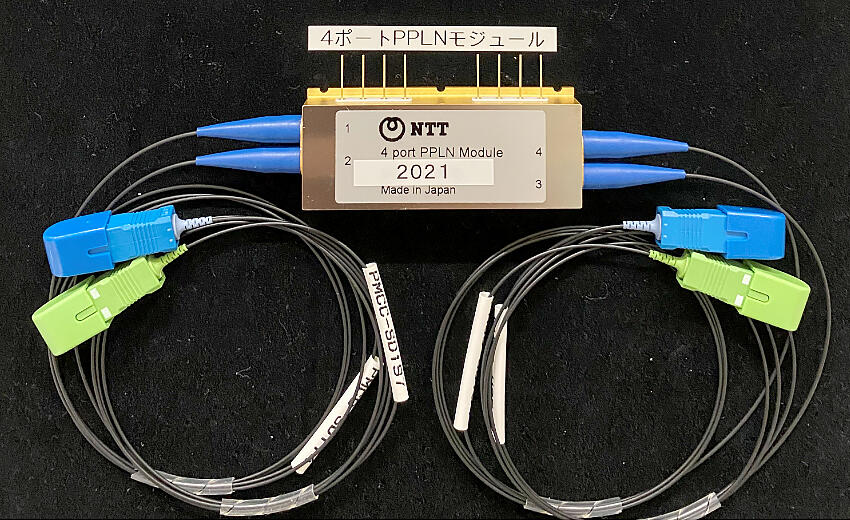NTT, in collaboration with the University of Tokyo and RIKEN, has developed an optical fiber-coupled quantum light source (squeezed light source) module as a key technology for realizing a rack-sized large-scale optical quantum computer. Furthermore, using this module and optical fiber components for optical communication, the company succeeded in developing the world's first optical fiber engineering system to generate continuous-wave squeezed light in which quantum noise is squeezed by more than 75% over a wide band of more than 6 terahertz. This enables the development of optical quantum computers on a realistic device scale in a stable and maintenance-free closed system using optical communication devices, and this will greatly advance the development of actual machines. In the future, the company will develop an actual optical quantum computer composed of optical fiber components in combination with various photon operations under verification; furthermore, the company will improve the quantum light source to increase quantum noise squeezing to realize fault-tolerant large-scale universal photon computers.

Provided by NTT
Quantum computers are being researched and developed worldwide because they can process massive parallel calculations using the phenomena unique to quantum mechanics, such as superposition and entangled states. Currently, various methods have been devised, and among them, the optical quantum computer using photons, which are the quantum of light, has many advantages. For example, it does not require the low temperature or vacuum equipment required by other methods, which makes it compact. By creating a temporally continuous entangled state, the number of qubits can be increased almost infinitely without the integration or parallelization of devices. In addition, high-speed computational processing is possible, because of the broadband property of light.
Quantum error correction has been theoretically shown using the parity of the photons, which can be performed by using a method to represent quantum bits with a large number of photons rather than with one photon. Furthermore, this method has a high affinity to optical communication technology, and it is possible to use low-loss optical fibers in the communication wavelength band and high-performance optical devices cultivated in optical communication. Furthermore, dramatic development towards the construction of actual machines can be expected. However, it is difficult to generate squeezed light, which is the origin of the quantum nature of this optical quantum computer, and so far, there has been no high-performance optical fiber-coupled quantum light source that operates in the optical communication wavelength band. The squeezed light has an even number of photons and squeezed quantum noise and generates quantum entangled state. In addition, as quantum error correction becomes possible by using the parity of the number of photons, squeezed light plays an extremely important role in quantum error correction. To realize these, it is necessary to have light that maintains parity even in the high photon number components and has a highly squeezed quantum noise. For example, the generation of time-domain entanglement (two-dimensional cluster state) capable of performing large-scale quantum computation requires a quantum noise squeeze rate of more than 65%.
In this joint research, the company has newly developed an optical fiber-coupled quantum light source module (optical parametric amplification module) that operates at optical communication wavelengths. In the periodically poled lithium niobate waveguide, which is the heart of the module, the manufacturing method has been renewed to achieve low loss. In addition, using the optical communication device mounting technology cultivated by NTT, the company has developed a low-loss optical fiber coupling type module. Furthermore, in a closed system using the developed module and optical fiber components, the company succeeded for the first time in the world in producing continuous-wave squeezed light in which quantum noise is squeezed by more than 75% over a wide band of more than 6 terahertz. This means that the key device in optical quantum computers could be realized in a form compatible with an optical fiber while maintaining the broadband of light. This makes it possible to develop a rack-sized optical quantum computer on a realistic device scale in a stable and maintenance-free closed system using optical fibers and optical communication devices, and it is expected that the development of the actual machine will make great progress. The result was published in the American scientific journal Applied Physics Letters on December 22nd.
This joint R&D was conducted with support from the project "Development of Large-scale Fault-Tolerant Universal Optical Quantum Computers" (Project Manager: Akira Furusawa, Professor, Graduate School of Engineering, The University of Tokyo), under the Japan Science and Technology Agency Moonshot R&D Project Moonshot Goal 6 "Realization of a fault-tolerant universal quantum computer that will revolutionize economy, industry, and security by 2050" (Program Director: Masahiro Kitagawa, Professor, Graduate School of Engineering Science, Osaka University) project "Development of Large-scale Fault-Tolerant Universal Optical Quantum Computers" (Project Manager: Akira Furusawa, Professor, Graduate School of Engineering, The University of Tokyo). Project Manager Furusawa said, "Until now, integrated circuits were considered essential for the realization of large-scale quantum computers. However, this success proves that integrated circuits are not necessary and that modules and fiber optic optics are sufficient. As a result, the realization of large-scale quantum computers became a reality at once, and it can be said that a revolutionary technology was born."
This article has been translated by JST with permission from The Science News Ltd.(https://sci-news.co.jp/). Unauthorized reproduction of the article and photographs is prohibited.




